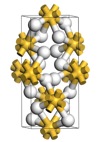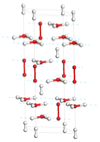


“One of the continuing scandals in the physical sciences is that it remains in general impossible to predict the structure of even the simplest crystalline solids from a knowledge of their chemical composition.” J. Maddox Nature 335, 201(1988)
This is finally changing with approaches including: genetic algorithms, metadynamics, graph theory and so on …

A simple recipe
1. Make a random unit cell
2. Throw a given number of atoms, of given type into the unit cell
3. Relax carefully under quantum mechanical forces and stress
4. Repeat
5. Look for lowest enthalpy or most “interesting” structures


The approach was introduced in:
C. J. Pickard and R. J. Needs, High-pressure phases of silane, Physical Review Letters, 97, 45504, 2006
and recently used to elucidate a high pressure phase of hydrogen:
C. J. Pickard and R. J. Needs, Structure of phase III of hydrogen, Nature Physics, 3, 473–476 (2007)













